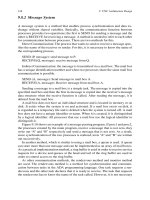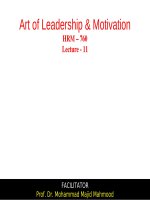Organization theory and design: Lecture 11
Bạn đang xem bản rút gọn của tài liệu. Xem và tải ngay bản đầy đủ của tài liệu tại đây (22.42 KB, 8 trang )
The External Environment
11
1
The External Environment
Basics
• Organizational environment is defined as
all elements that exist outside the
boundary of the organization and have
the potential to affect all or part of
organization
• An organization’s Domain is the chosen
environmental field of action (niche)
2
The External Environment
Sectors
•
Environment comprises of various sectors:
1. Industry
2. Raw material
3. HR sector
4. Financial resource sector
5. Market sector
6. Technology sector
7. Economic conditions sector
8. Government sector
9. Sociocultural sector
10. International sector
3
Environmental Uncertainty
• Simple/complex dimension
• Stable/unstable dimension
4
Adapting to Environmental
Uncertainty
• Refer to open systems theory
• Each sector in the external environment
requires an employee or department to
deal with it
• Buffering departments
• Boundary spanners
• Departmental Differentiation & Integration
5
Adapting to Environmental
Uncertainty
Organic and Mechanistic Design:
• Stalker’s study: “When the external
environment was stable, the internal
organization was characterized by rules,
procedures, and a clear hierarchy of
authority….in a rapidly changing
environment the internal organization
was much loose, free-flowing, and
adaptive.”
6
Adapting to Environmental
Uncertainty
Mechanistic Form
1. Tasks are broken down into specialized
separate parts
2. Tasks are rigidly defined
3. Strict hierarchy of authority and control,
many rules
4. Knowledge and control of tasks are
centralized at the top of the organization
5. Communication is vertical
7
Adapting to Environmental
Uncertainty
Organic Form
• Employees contribute to the common tasks of
the department
• Tasks are adjusted and redefined through
teamwork
• There’s less hierarchy of authority and control,
a few rules
• Knowledge and control of tasks are located
anywhere in the organization
• Communication is horizontal
8









